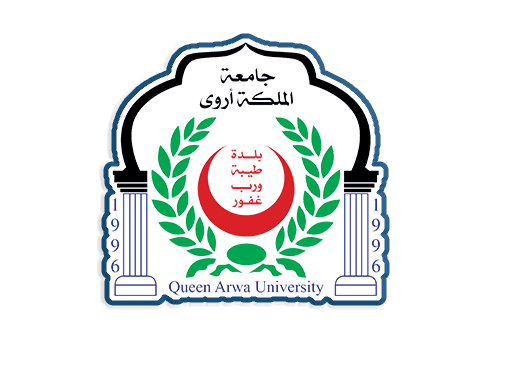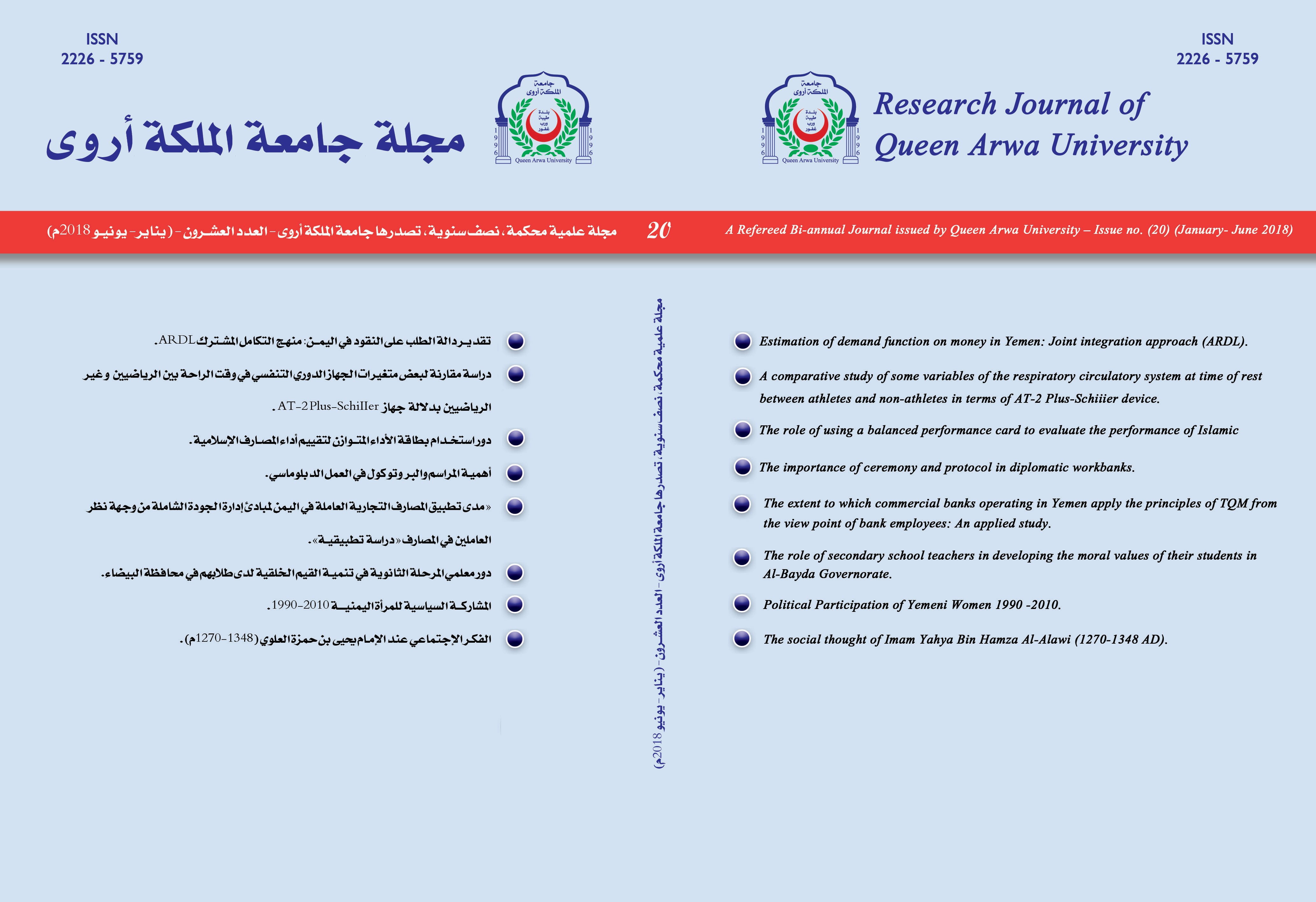تقدير دالة الطلب على النقود في اليمن
منهج التكامل المشترك ARDL
DOI:
https://doi.org/10.58963/qausrj.v1i20.178الكلمات المفتاحية:
الأرصدة النقدية ، الاقتصاد اليمني ، سعر الفائدةالملخص
يهدف البحث إلى محاولة التعرف على العلاقة طويلة وقصيرة الأجل بين الأرصدة النقدية الحقيقية وبين العوامل المحددة لها (الدخل الحقيقي، ومعدل التضخم، وسعر الفائدة، وسعر الصرف) في الاقتصاد اليمني باستخدام بيانات شهرية تغطي الفترة من يناير 2005 إلى نوفمبر 2014. وقد استخدم منهج الانحدار الذاتي لفجوات الإبطاء الموزعة للتكامل المشترك (Autoregressive Distributed Lag (ARDL) approach to cointegration)، والذي يعد من المناهج القياسية الحديثة المستخدمة في تقدير دالة الطلب على النقود، وتشير نتائج التقدير إلى وجود تأثير معنوي إحصائياً للعوامل المحددة للطلب الحقيقي على النقود بمعناها الواسع في الأجل الطويل في الاقتصاد اليمني. في حين يتأثر الطلب الحقيقي على النقود، في الأجل القصير، بكل من الدخل الحقيقي، وسعر الفائدة، وسعر الصرف، فقط، ومع ذلك كشفت النتائج عن انخفاض أثر كل من سعر الفائدة، وسعر الصرف في الأجل القصير عنه في الأجل الطويل. كما كشفت نتائج الدراسة من خلال اختبار الاستقرار CUSUM, CUSUMQ Test أن الطلب الحقيقي على النقود بمعناه الواسع تتسم بالاستقرار بما يسمح للسلطات النقدية الاعتماد على دالة الطلب على النقود في صياغة سياسة نقدية فاعلة.
التنزيلات
المراجع
المراجع باللغة العربية
الحكيمي، سيف سلام (2008): "قياس استقرار دالة الطلب على النقود"، مجلة شؤون العصر، السنة الثانية عشرة، العدد: الثامن والعشرون.
المراجع باللغة الانجليزية
Abdulkheir, A.Y., (2013), “An Analytical Study of the Demand for Money in Saudi Arabia”, International Journal of Economics and Finance, Volume: 5/4, pp. 31-38, Canada.
Agenor, Pierre-Richard and Mohsin Khan.(1996), "Foreign Currency Deposits and Thedemand for Money in Developing Countries". Journal of Development Economics: pp. 101-118.
Anwar, S. and Asghar, N. (2012), “Is Demand for Money Stable in Pakistan”, Pakistan Economic and Social Review, Volume: 50/1 (Summer 2012), pp. 1-22, Pakistan.
Arango, S. and Nadiri, I.M. (1981), “Demand for Money in Open Economies”, Journal of Monetary Economics, Vol.7, No.1, pp. 69-83.
Baharumshah, Ahmad Zubaidi, Siti Hamizah Mohd and A. Mansur M. Masih (2009), “The stability of money demand in China: Evidence from the ARDL model”, Economic Systems, 33(3): 231-244.
Brown, R. L., J. Durbin, and J. M. Evans (1975), "Techniques for Testing the Constancy of Regression Relationships over Time". Journal of the Royal Statistical Society. Series B (Methodological) 37: 149-192.
Budha, B. B. (2012), "Demand for Money in Nepal: An ARDL Bounds Testing Approach" NRB Working Paper No. 12. Nepal Rastra Bank, Nepal.
Budha, B.B. (2011), "An Empirical Analysis of Money Demand Function in Nepal." Economic Review, Occasional Paper, No 23. Nepal Rastra Bank, Nepal.
Chaisrisawatsuk, S., S. C. Sharma, and A. R. Chowdhury (2004), "Money Demand Stability under Currency Substitution: Some Recent Evidence". Applied Financial Economics 14: 19-27.
Darrat, A. F., and A. Al-Mutawa (1996), "Modelling Money Demand in the United Arab Emirates". Quarterly Review of Economics and Finance, 36: 65-87.
Dritsakis, N. (2011), “Demand for Money in Hungary: An ARDL Approach”, Review of Economics and Finance, November 2011, pp. 1-16, Canada.
Engle, R. F., and C. W. J. Granger (1987), "Co-Integration and Error Correction: Representation, Estimation, and Testing". Econometrica 55: 251-276.
Goldfeld, S.M. & Sichel, D.E. (1990), "The Demand for Money", in: Friedman and Hahn, eds., Handbook of Monetary Economics. Amsterdam: Elsevier Science Publishers. pp. 300-356.
Imimole, B., Uniamikogbo, S. O.,(2014), "Testing for the Stability of Money Demand Function in Nigeria", Journal of Economics and Sustainable Development, Vol. 5, NO: 6, ISSN 2222-1700 (Paper) ISSN 2222-2855 (Online). www.iiste.org
Johansen, S. (1992) "Testing Weak Exogeneity and the Order of Cointegration in Uk Money Demand Data". Journal of Policy Modelin". 14: 313-334.
Johansen, S., and K. Juselius (1990) "Maximum Likelihood Estimation and Inference on Cointegration—with Applications to the Demand for Money". Oxford Bulletin of Economics and Statistics, 52: 169-210.
Kjosevski, J.(2013) "The determinants and stability of money demand in the Republic of Macedonia", Zb. rad. Ekon. fak. Rij. vol. 31. sv. 1: 35-54
Maravić, Jelana, and Mirjana Palić (2010), “Econometric Analysis of Money Demand in Serbia”, Working Paper.
Narayan, P.K., (2005), "The saving and investment nexus for China: evidence from cointegration tests". Appl. Econ. 37, 1979–1990.
Obben J. (1998), "The demand for money in Brunei", Asian Economic Journal, Vol: 2, No: 12, pp. 109-121.
Oluwole, O. and Olugbenga, A. O. (2007). “M2 targeting, money demand, and real GDP growth in Nigeria: Do rules apply?”, Journal of Business and Public Affairs, 1(2): 1-20.
Pesaran, M. H., and B. Pesaran (1997) Microfit 4.0 (Window Version). New York: Oxford University Press.
Pesaran, M. H., Shin, Y., Smith, R.J. (2001), “Bounds Testing Approaches to the Analysis of Level Relationships". Journal of Applied Econometrics, 16: 289-326.
Pesaran, M. H., Y. Shin, and R. J. Smith (1996) Bounds Testing Approaches to the Analysis of Level Relationships. DEA Working Paper 9622, Department of Applied Economics, University of Cambridge.
Walsh, C. E. (2003), "Monetary Theory and Policy". Second Edition. The MIT Press, USA.
Weliwita, A., and E. M. Ekanayake (1998) Demand for Money in SriLanka during the Post-1977 Period: A Cointegration and Error Correction Analysis. Applied Economics, 30: 1219-1229.
التنزيلات
منشور
إصدار
القسم
الفئات
الرخصة
الحقوق الفكرية (c) 2018 للمؤلف (المؤلفين)

هذا العمل مرخص بموجب Creative Commons Attribution 4.0 International License.












